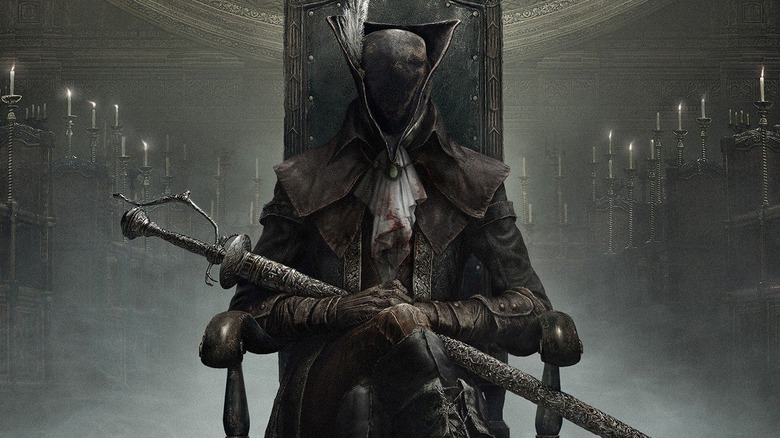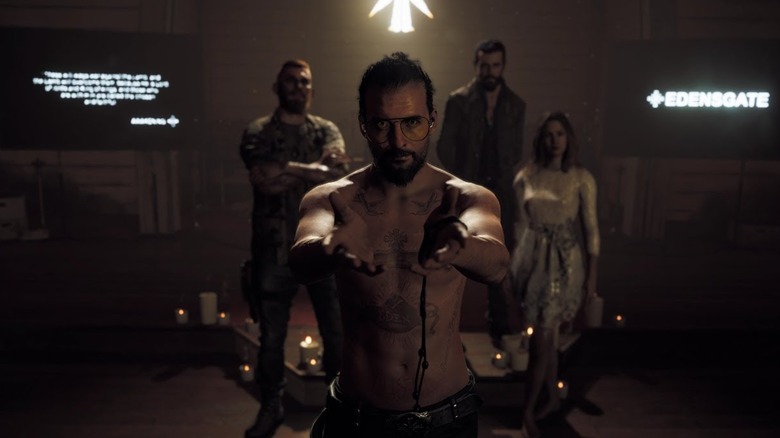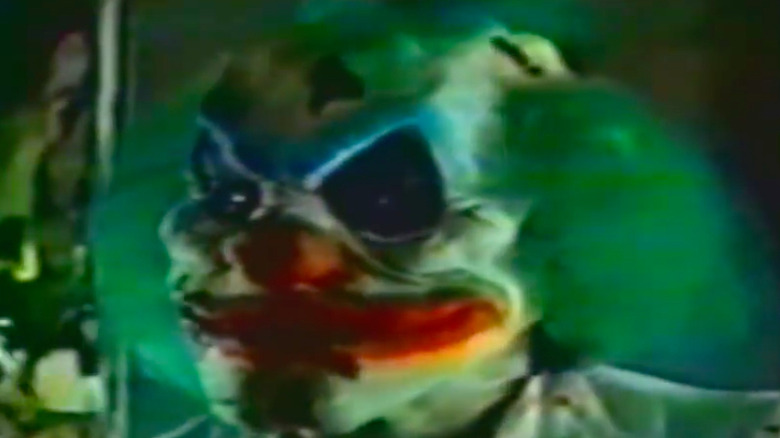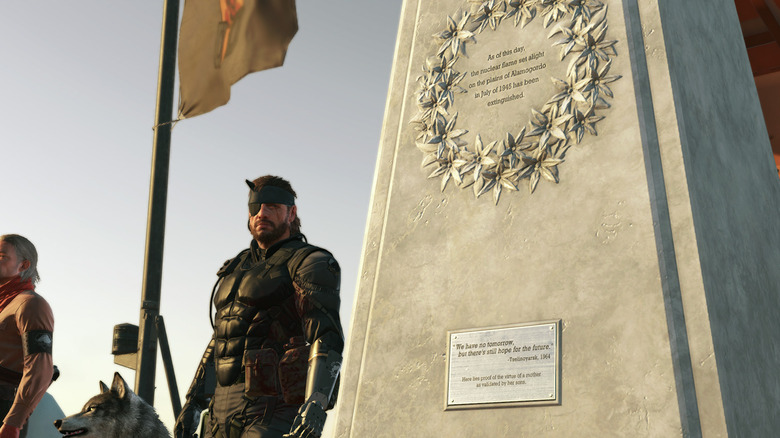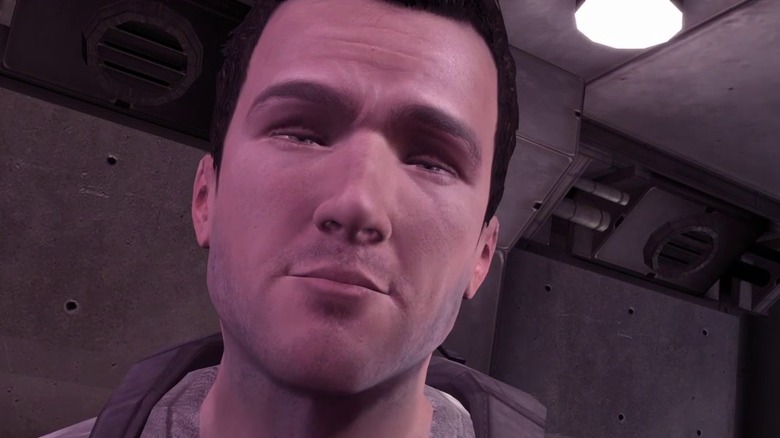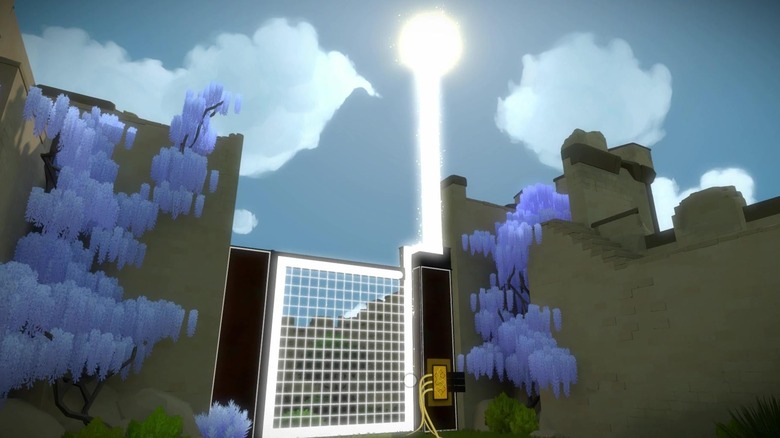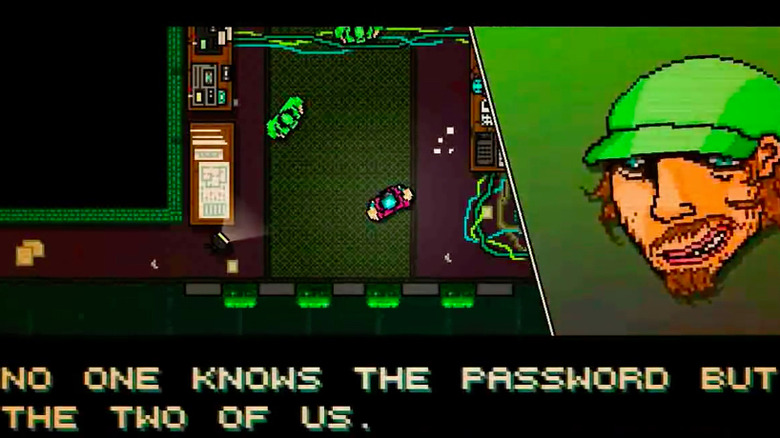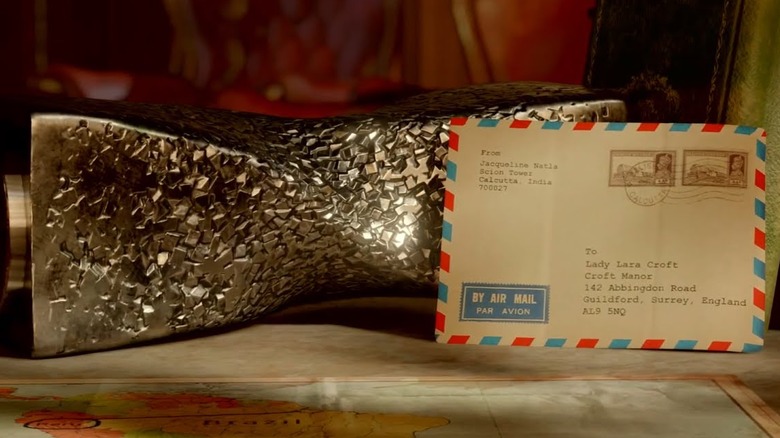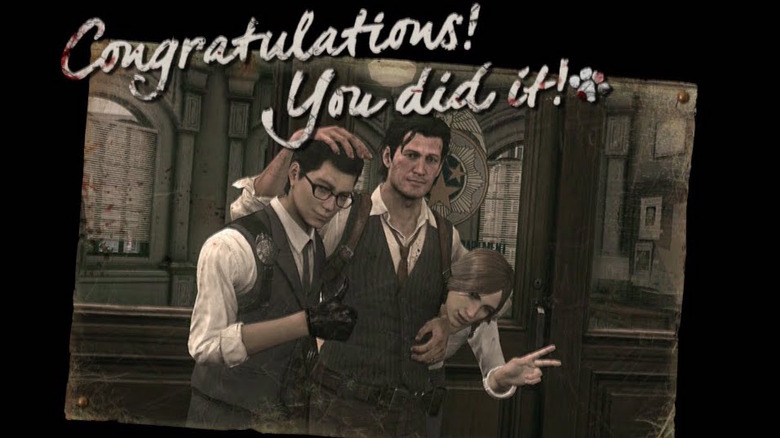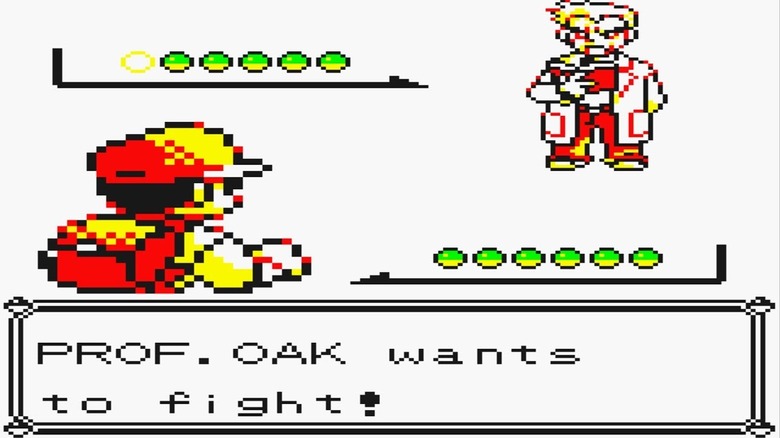Awesome Alternate Endings Few People Know About
There's a lot of work that goes into the production of a good game. Average players rarely see every single detail a game has to offer, but that doesn't deter developers from leaving extra content lying around. Determined completionists or curious gamers sometimes find that the game doesn't end with a victory screen, the credits, or even with sniffing out every last collectible.
Alternate endings come along just when you thought it was safe to put down the controller. Oftentimes, these hidden endings give a new perspective on the game's story, providing players with the "true" end to their tale, perhaps even teasing that there is more to come. They are a way to encourage gamers to play outside the box in order to discover branching narratives, and to consider the consequences of their in-game actions. Or they're just really, unaccountably weird and probably an inside joke of some sort.
For those unsatisfied with the average ending, here are weird and wonderful alternate endings carefully crafted into your favorite games.
God of War's thunderous future
The latest — and perhaps greatest — installment of God of War features Kratos beating his way through a brand new pantheon of gods and goddesses. While playing, you may have had to brush up on your Norse mythology, considering that you don't take on the most obvious names in the lore. There are no Loki, Odin, or Thor boss fights. Yet.
However, if you beat the game, then you can choose to head home and have Kratos and Atreus sleep in their shabby beds. If you do, then the screen darkens and reads, "Years later..."
Thunder rumbles and lightning rips open the roof. Running outside, Kratos and Atreus find an imposing figure standing in the storm. Whipping back his cloak, the mysterious man reveals a familiar weapon: a hammer, alive with lightning. The fight we've all been waiting for has arrived. Thor is likely out for vengeance for his two sons, Magni and Modi, who died by the player's axe (and Atreus' knife) earlier in the game.
Before the fight can start, the screen blackens, bringing players back to "Present Day." The cutscene was apparently all just a dream, but when Atreus tells his father about it, he says that it felt more like a premonition. Fans have speculated that this hints at a possible sequel game or future DLC content.
Heavy Rain's heaviest ending
Heavy Rain is a dark game to begin with, but the ending wherein the player fails to save Shaun and lands Ethan in prison, aptly named "Helpless," is perhaps the grimmest scene in the game. You'd have to miss a whole lot of button mashing in the quick time events to get to this hopeless end. The protagonist, Ethan Mars, has seven different possible endings that the player can guide him toward. Ultimately, the goal would be to survive the impossible tasks set out for him by his son's kidnapper, the Origami Killer, in order to get the information required to find and save little Shaun from drowning.
However, there's a lot that can go wrong along the way. With Ethan's history of blackouts after the death of his son Jason and his general shady behavior, the police start to suspect that maybe he is the culprit.
In the "Helpless" epilogue, Ethan is arrested, having been framed as the Origami Killer. Unable to save his son, he has lost everything. In a jail cell filled with scattered origami figures, Ethan turns to a conveniently placed noose and hangs himself. While this isn't the only ending in which he commits suicide, it is certainly one of the darkest.
Beat Far Cry 4 in 15 minutes through sheer patience
Far Cry 4 provides all the running and gunning, explosions, and creative kills you've come to expect from a Far Cry title, but all that pesky gameplay can be skipped over with just a little bit of patience. You can complete the game via a pseudo-pacifist route if you wait around for a warlord who just had a busload of people slaughtered before your eyes.
Within the first fifteen minutes of the game, you find yourself in the charismatic Pagan Min's palace back in the protagonist's home country of Kyrat. This guy gives off all kinds of red flags: he stabbed one of his own men to death, he brutalized your buddy, and he took a taste of your mother's ashes from her urn. But, if you believe in second chances and wait for about fifteen minutes in the dining room that you're clearly meant to escape from for his return from a torture chamber, then you're rewarded with an alternate ending.
Helping you on your mission to scatter your mother's ashes, Pagan Min tells you about how he and your mother had been in love, even having a daughter together before your father, Mohan Ghale, killed her. It is beside your half-sister's ashes where you finally leave your mother's. Having completed your objective, Pagan Min invites you to go "shoot some goddamn guns."
Yuna and Tidus get their reunion
Everyone loves a story of star-crossed lovers, and the story of Yuna and Tidus from Final Fantasy is no exception. The two are literally made for each other — Yuna's name meaning "night" and Tidus' "sun" in Okinawan — but fate, or in this case the fayth, keeps them apart. In the true convoluted nature of Final Fantasy lore, it's iffy on whether or not Tidus is actually real.
After the events of Final Fantasy X, Tidus discovers that he and many others are just the dreams of dead people known as the fayth. His whole reality is an alternate ending, so to speak. At the game's conclusion, when the dreaded Sin is defeated and the fayth can stop dreaming, he fades out of existence, leaving Yuna behind. Thus, the sequel title Final Fantasy X-2 is all about Yuna searching for Tidus and hopefully reuniting with him.
For most players, this never happens. However, the "perfect" ending has Yuna and Tidus finding each other again, his existence no longer ambiguous. It's a very touching cinematic, and a welcome reward to those who worked so hard to find it.
Chrono Trigger's secret ending honors its creators
Sometimes designers and developers put their own personal touch into the games they create. Occasionally that means actually including themselves in some shape or form in the final product. This trend may have been popularized by the team behind Chrono Trigger. Often hailed as one of the greatest games of all time, Chrono Trigger was the product of the mastermind behind Final Fantasy, Hironobu Sakaguchi; the creator of the Dragon Quest series, Yuji Horii; and Dragon Ball and Dragon Ball Z's very own Akira Toriyama. Dubbed "the dream team," they created the new standard for JRPGs.
The game was initially released to SNES in 1995, but the myriad of ports that came later featured a secret homage to the dream team themselves. One of 13 possible endings, the "Dream Project" ending gives the player a chance to chat with the creators. They talk about the ups and downs of game development and cheekily threaten to delete the player's save file. Or throw them into a boss fight. Talk about a toxic dev-community relationship.
Collect umbilical cords to become Bloodborne's nightmare boss
Bloodborne is no stranger to the strange. So it follows that its true ending would be the weirdest and slimiest possible, coming only after one of the most merciless fights FromSoftware has ever created.
Two of the three endings have the player battling against the First Hunter, Gehrman, which is challenging in and of itself. But if skilled players want an even more demanding brawl, then the PlayStation-exclusive is more than happy to oblige, so long as the Hunter has found and consumed at least three umbilical cords prior to fighting Gehrman. You know, like a sensible person.
These umbilical cords are tied to the Great Ones, the eldritch monsters responsible for the beastly havoc in Yharnam. They're also each searching for a surrogate child, and the final boss known as Moon Presence is no exception. Having killed this Great One's surrogate Gehrman, Moon Presence turns to the Hunter as a replacement.
Upon defeating this very final boss, the player has effectively transcended humanity in defeating these old gods. Thus the player becomes the next step in evolution: a slimy squid squirming on the ground. Reborn as a baby Great One, the player is found and picked up by The Doll.
Inside's deep and dark and difficult secret
2016's Inside is the spiritual successor to Limbo. Like its predecessor, the game is minimalist, brutal, and gives the player little to go off of when it comes to plot or what's actually going on. You just have to play it, die, and retry. If you're stubborn enough to keep that up and get to the end of the game, you might be disappointed. True to Playdead's particular, mysterious M.O., the ending of Inside is ambiguous. There's no great evil triumphed over, and you're not really sure what comes next.
Inside's alternate ending complicates things further. After keen-eyed players (or those who followed a guide) have shut off all of 14 secret power orbs throughout the game and listened carefully to the tones of two different radios earlier on, the alternate ending is unlocked. This leads the player to a bunker of sorts in a cornfield, opened by directions that correspond to the musical tones. Inside the gloom of the bunker is a computer and a mind control device similar to the one the nameless protagonist uses throughout the game to control lifeless bodies. Upon unplugging the device, the boy slumps over, apparently dead.
What does this mean? There have been many prominent theories, some gamers believing it to be a commentary on the concept of player control. But ultimately there have been no straight answers.
The forest fire wins in Firewatch
Firewatch is filled with mysteries that are slowly solved, but the alternate ending is a no brainer. Throughout the game, players are assured that their actions have consequences; usually that means trying not to be a jerk through dialogue options and keeping from going crazy as a conspiracy unfurls around you.
But for the most part, the game is pretty chill. Putting aside disappearances, break-ins, and shady government research sights, the actual antagonist of the game is wildfire. It's why Henry took a job as a fire lookout in the middle of nowhere Wyoming. When fire does eventually breakout, the lovely vistas Henry watched over are no longer safe. As difficult as it might be to leave, when the rescue helicopter comes, you have to get on.
Or you don't. If you choose to dawdle in the flaming forest for too long, the helicopter meant to save you at the end will abandon you and the credits will roll. Whether or not this means Henry dies is just another one of those mysteries.
Say goodbye to your save data in Nier's ending E
A common theme in the Nier games is sacrifice. Friends sacrifice themselves for the sake of the player's progress and hard choices are made. Rather than go for challenging gameplay, the fourth ending option in the Square Enix game puts the player in a difficult position. You can save your friend Kaine from suffering an agonizing death, but to do so you must sacrifice your very existence.
This is demanding to begin with, but what's more is that the game really means it. The memory of you as a player ever existing is erased. Which means your save data is gone.
This is replicated in Nier's more popular sequel, Nier: Automata. You can save yourself from a dismal ending through choosing ending "E." In this option, you fight through the credits via a bullet-hell like simulation, and it really is hellish. If you die enough, help is offered by players who have already completed the game. They give you the extra firepower you need to defeat the credits. At the very end, you have a choice. You can save your data, or "help the weak" and rescue another player, just as others did for you.
Which comes at the cost of your save data.
such wow much surprise: the dog did it
The Silent Hill games are designed to make players uneasy. Silent Hill 2 did so through claustrophobic fog and the nightmarish creatures that lurked within. It's subtle in its scares, not excessive as some games that focus on jumpscares can be. Protagonist James Sunderland's journey through the mists and mysteries of the town are anything but over the top.
Except some of the endings are. One in particular.
Before shiba inu memes were cool, there was Mira — the dog controlling all the weirdness in Silent Hill 2 in a high tech control booth behind the scenes. James discovers her operating levers and wearing a headset after finding a key in a dog house. As he falls to his knees in disbelief, Mira licks his face reassuringly. The credits roll to Mira's own delightful rendition of the ending theme, her stoic face watching over Silent Hill 2's most memorable ending.
This is just one of two different joke endings in the survival horror series. The other is a recurring UFO ending that is included in the first three games, and alluded to in the fourth. Mira made her mark as the mastermind of evil, however, and was later incorporated into future UFO endings, even going on to become a playable character in Silent Hill: The Escape.
Just walk away in Far Cry 5
In Far Cry 4, there was a hidden alternate ending that could be revealed if the player decided to do nothing to escape during the game's opening scenes. Seizing upon this concept, Ubisoft included a similar ending in Far Cry 5. Just like the last one, all you need to see this ending is a bit of patience.
In the opening scenes of the game, your character is tasked with arresting psychotic cult leader Joseph Steed. All you have to do is simply ignore the sheriff's pleas to do your dang job and wait a few minutes.
Then, the sheriff will lower the perp's hands for him and solemnly tell you that it's time to leave. You and your team will make your way to the door of the church, with US Marshall Burke begging the sheriff to turn around and reconsider. The sheriff has come to the decision that they're all going to die if Steed gets handcuffed, so he leads you and Burke outside ... and the credits roll.
It's considerably less humorous than Pagan Minh being excited to "finally" shoot some stuff in Far Cry 4's secret ending, which kind of fits the dire tone of Far Cry 5. Even its shortcuts are darker and more upsetting.
Twisted Metal's live action dramas
Created during the heyday of full-motion video games, these grainy, VHS-copy-of-a-copy-looking tapes are all that remain of the original endings for Twisted Metal.
These were meant to be displayed at the end of single-player campaigns, with a different scene playing depending on which character was declared the victor. These were left on the cutting room floor, replaced by the simpler text-based endings that fans are familiar with. While there doesn't seem to be any one official reason why these endings weren't used, the low production value is the most likely culprit. The acting is hammy, the sets and costuming are embarrassing, and you can literally see the boom mic fall into frame during several sequences. Not a great look, especially for a game that would end up launching a franchise.
The scenes were eventually collected in all of their unpolished glory and released as a bonus feature on the second disc of Twisted Metal: Head-On — Extra Twisted Edition. In their review of Head On, GameZone likens these cutscenes to the quality of a Sega CD FMV game, a la Night Trap or Sewer Shark. As GameZone says of these scenes, " Watch one and you'll know why they were deleted."
World peace in Metal Gear Solid 5
Leave it to Hideo Kojima to create a hidden ending that is incredibly optimistic, but still makes us all feel bad about ourselves. While searching through the code of Metal Gear Solid 5: The Phantom Pain, one player discovered a hidden cutscene that was meant for MGS5's online multiplayer, but seemingly could not be triggered in-game.
Players began to theorize how they could legitimately see this scene, in which Big Boss and the rest of the characters celebrate the total disarmament of nuclear weapons around the world, which ushers in a new era of peace and cooperation. Konami eventually told players that they literally had to do just that. The cutscene could only be activated if everyone playing online multiplayer disarmed their nukes. This is an incredible concept for two reasons: it not only perfectly ties into the themes of the Metal Gear Solid series, but it encourages an unprecedented level of cooperation between gamers.
Naturally, when the ending was eventually played for gamers, it was only because of some kind of system error in the Steam version of the game. In response to the glitch, the official Metal Gear Solid Twitter account apologized and tweeted, "We have implemented a series of counter-measures during today's server maintenance to resolve this issue and prevent this from happening in the future."
Which all just begs that age-old question: why can't we all just get along?
Shadow Complex's status update
While some of the endings on this list require specific conditions to be met (or a total lack of effort), this is the only one that requires your character to fight extra hard for his right to be a total jerk.
Early in the game, the player's character, Jason, sees his girlfriend get kidnapped and taken away in a helicopter. This sets in motion the rescue mission that takes up most of the rest of the game's plot.
Instead of doing that, though, you may opt to backtrack to a jeep, blasting your way through soldiers. Once you get to the jeep, your character will hop in and get the heck out of the jungle. This triggers a cutscene where Jason drives away from all of the action, quipping to himself, "Eh, plenty of fish in the sea."
Putting aside how morally messed up this alternate ending is, finding this hidden scene in Shadow Complex Remastered will earn players an in-game achievement: "Status Update: Single." Yikes. This scene was probably made as a joke, but it looks for all the world like Jason isn't the hero we're led to believe.
The Witness lets you become the developer
Released in 2016, The Witness is an immersive first-person puzzle game. While the game is light on plot, it's not without its surprises, with IGN's review noting its "wealth of mysteries to unravel." In fact, it has a pretty interesting hidden ending of its own. Much like the previously mentioned Far Cry 5 and Shadow Complex, this ending is accessible near the start of the game.
After entering the first open-air section of the game, you can use your cursor to click on the sun shining brightly overhead. This will trigger a secret entrance that will lead you through several rooms and tunnels, eventually depositing you in an empty abyss. Within the abyss, a rather curious cutscene is triggered.
Still in a POV shot, we cut to live action. A man gets out of bed, unplugging various wires from his body. He wanders through his building (which appears to be the studio space for Thekla, the developers of the game), past computer screens and a briefly-seen jar of urine (yikes). He eventually makes his way to a backyard and lays down, looking up at the sky.
It's really bizarre and still doesn't offer much in the way of explanation for the events of the actual game. The monitors attached to this character (presumably lead game designer John Blow) seem to suggest some kind of simulation is at work. This is a cool ending that lends The Witness even more ambiguity.
Hotline Miami: the janitors did it!
In regards to Hotline Miami's story, IGN's review mentioned the game's "scenes of surrealist intrigue" as being one of the more interesting aspects of its narrative. There may not be a story beat in Hotline Miami more peculiar than the extended ending featuring the two psychotic janitors who have been manipulating the game's events from behind the scenes.
By finding 12 lettered tiles scattered throughout the game and entering them on a computer seen in Chapter 19, you gain access to a secret ladder. Heading down into these tunnels will bring you face to face with two janitors who have secretly been behind the entire events of the game, as they are part of a conspiracy to overthrow the government. This dialogue also clarifies a few things about the alternate history in which this game takes place, revealing the government in this world to be called the Russo-American Coalition.
Once they give you a spiel about the righteousness of their cause, the "Chapter Clear" title pops up on the screen. After this, you're free to just walk right up to the two masterminds and kill them in any way you see fit. Then it's back to your motorcycle, where you ride off into the credits.
It's a really bizarre twist to throw into the literal last minutes of the game, but the fact that it's hidden behind a long fetch quest of a puzzle is an even stranger choice.
Shadow of the Tomb Raider's original post-credits scene
Sometimes, fans can be so excited to dive into a game that they'll gain access to content before the game's developers realize it wasn't supposed to be included. That's what happened with this post-credits scene in Shadow of the Tomb Raider. In it, series hero Lara Croft receives a letter addressed to her from Jacqueline Natla, who Tomb Raider fans may recognize as the villain of the first game in the franchise. This seems to suggest the reboot series was beginning to come full circle with the original timeline, or would be telling its own version of the 1996 Tomb Raider's plot in the next installment.
This scene was actually removed by a Day One software patch from Square Enix, who explained that "multiple post-credits scenes were explored. Unfortunately one of the directions that was considered, but not chosen, was mistakenly included in the game. The Day One patch fixes this error."
However, one player — who didn't run the update — finished the game and saw this ending that was never intended for release. Upon realizing that nobody on the official Tomb Raider forums believed him about the scene, he uploaded his recording of the scene to YouTube.
It's a cool look at a possible route the storyline of the series could have taken. And who knows? Maybe Square Enix had decided to bring Natla back for the next game and didn't want to tip their hand too soon.
The Evil Within: The Consequence wants you to stick to the script
The Evil Within's second DLC, The Consequence, lives up to its title by showing you the consequences of sequence-breaking.
Toward the end of the game, you will come to a room called the STEM Hub, which houses the disembodied brain of the true villain pulling the strings behind the series' main storyline. Rather than continuing through this room and onto the final confrontation, you can opt to shoot the brain in the middle of the machine, which will trigger the hidden ending.
Shooting the STEM will cause the game to cut to black, skipping the final boss battle altogether. You will be berated for changing the events of the series' main timeline as the credits will roll, after which you'll be treated to a congratulatory screen showing a photo of the main characters celebrating.
Then the game will flash back to the moment before you pulled the trigger, as though the entire credits sequence had been a simulation brought about by the STEM. Your character will drop a surprised F-Bomb and the game itself will reward you with a trophy: "Stick to the Script."
It's not only a funny prank to play on both the player and the protagonist, but it's a clever way to tie-in an Easter egg with the overarching simulation plot lines that run through the Evil Within series.
The TRUE boss of Pokémon's first generation
Much has been made of Professor Oak's seemingly omniscient psychic abilities (which only seem to be activated when your character wants to fish or ride a bike in peace), but "the Pokémon Prof" was almost an even greater threat. That's right: at some point in the development of Pokémon Red and Blue, players were meant to face off against Professor Oak himself!
Only accessible through GameShark codes or absurdly specific glitches, this battle was unearthed from the code of the first generation of Pokémon games. There's no dialogue to suggest when this battle would take place during the game's story. However, the exceptionally high levels of the Pokémon in Oak's party — one of which is the opposite type Starter from whichever one you picked, just like your Rival has in the real final battle — would seem to indicate that he was originally meant to be the final boss of the game.
It's a shame that this battle was cut, since it could have been a really neat way of bringing the first game's quest full circle. No one seems to know why this was removed from the final game. Maybe it had something to do with the developers wanting to give players a Rival character in their age range, rather than putting a beatdown on a septuagenarian at the close of the game.

